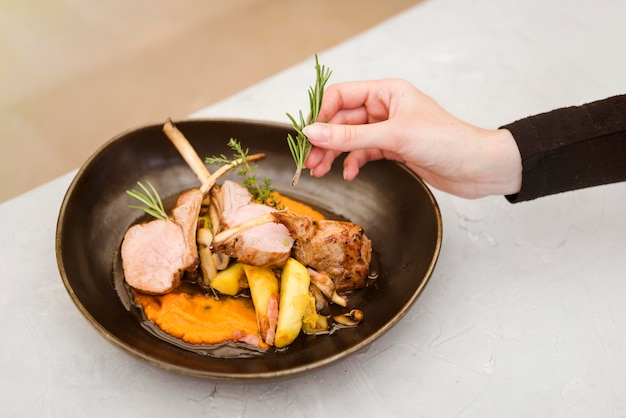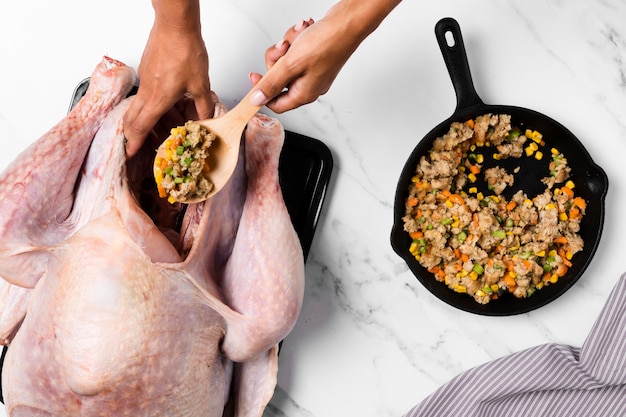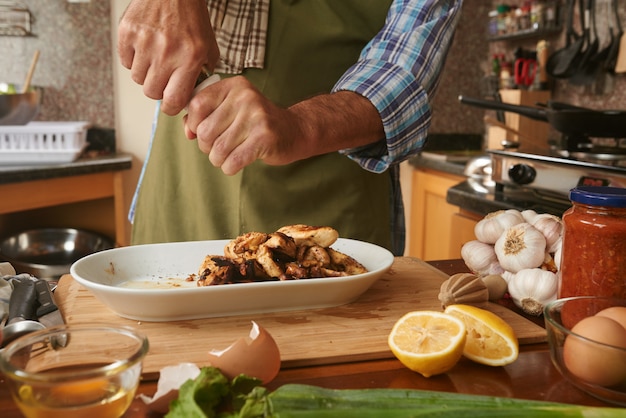The slow cooker is a kitchen hero, transforming tough cuts of meat into tender, flavorful masterpieces. But what about those times when you need dinner on the table faster? Enter the high setting. It’s the turbocharged lane of slow cooking, promising a quicker route to deliciousness. However, navigating the high setting requires a bit of finesse. It’s like the fast lane on a busy highway – you need to know the rules and drive with confidence to reach your destination safely and with a smile on your face.
As a seasoned slow cooker enthusiast, I’ve spent countless hours experimenting and learning the ins and outs of high setting cooking. While the high setting promises speed, it’s essential to understand the nuances and potential pitfalls to ensure a satisfying culinary experience. This guide will equip you with the knowledge and techniques to conquer the high setting and create succulent, mouthwatering pork dishes.
(Part 1) Understanding the High Setting: A Deep Dive

Imagine the high setting as your trusted sidekick in the kitchen. It’s capable of accelerating the cooking process, but just like any powerful tool, it needs to be wielded with care. Here’s what you need to know about the high setting:
1. The Power of High Heat
The high setting in your slow cooker delivers a higher, more intense heat than its low-setting counterpart. This translates to a faster cooking time, which is ideal for those evenings when you’re short on time. But the high heat also means you’ll need to be more attentive to ensure the meat doesn't dry out or overcook.
2. The Quest for Tenderness
The slow cooker is renowned for its ability to tenderize tough cuts of meat, but the high setting introduces a new dynamic. While the faster cooking time is a boon, it can sometimes impede the tenderization process. Think of it like a sprint versus a marathon. A sprint is fast but short, while a marathon requires a slower, sustained pace. We need to find that perfect balance, ensuring the meat cooks quickly while achieving that coveted tenderness.
3. The Importance of Liquid
When cooking on high, liquid is your best friend. Think of it as the slow cooker's secret weapon. It acts as a moisture barrier, preventing the meat from drying out. Broths, stocks, juices, or even plain water – all of these can be your culinary allies. Make sure to generously pour liquid into your slow cooker, ensuring the meat is submerged, allowing for the steam to work its magic, breaking down the tough fibers and infusing the meat with incredible flavor.
4. The Art of Spacing
Overcrowding your slow cooker is a recipe for disaster, particularly when using the high setting. The meat needs ample space to cook evenly. If you’re using a smaller slow cooker, consider cooking the meat in batches. Imagine a crowded train carriage – everyone is jostling for space, and no one is comfortable. Give your meat the space it needs to breathe, allowing for even heat distribution and a beautifully cooked result.
(Part 2) pork cuts and High Setting Cooking Times: A Detailed Guide

Now, let's get down to the nitty-gritty – the actual cooking times. Remember, these are guidelines, and the exact time will vary depending on the thickness of the cut, the brand of your slow cooker, and your personal preferences. Always check the meat's internal temperature with a meat thermometer to ensure it's cooked to perfection.
1. pork shoulder: A Classic Slow Cooker Star
The humble pork shoulder is a slow cooker staple. It’s incredibly flavorful and renders down beautifully in the slow cooker. For a bone-in pork shoulder, aim for a cook time of 4-5 hours on high. If you're working with a boneless shoulder, you can anticipate a slightly shorter cook time, around 3-4 hours.
Tips for Cooking Pork Shoulder on High:
- Embrace the Liquid: Generously add broth, stock, or even apple cider to your slow cooker. The liquid will help tenderize the meat and prevent it from drying out.
- Don't Skimp on Flavor: Add a blend of spices, herbs, and aromatics, like onions, garlic, paprika, and cumin, to enhance the flavor profile.
- The Power of Browning: Before adding the pork shoulder to your slow cooker, consider browning it in a skillet. This simple step creates a beautiful crust and intensifies the flavor.
2. pork loin: A Delicate Approach
Pork loin, known for its leanness, requires a delicate touch to prevent overcooking. For a tender and juicy result, aim for 2-3 hours on high. You can boost the moisture content by adding a few tablespoons of broth or apple cider to the slow cooker.
Tips for cooking pork loin on High:
- Keep it Moist: Add a touch of broth, juice, or even a splash of wine to the slow cooker to prevent the loin from drying out.
- Control the Heat: Monitor the cooking process closely, and if the pork loin seems to be browning too quickly, consider reducing the heat to low.
- Flavor Fusion: Enhance the flavor of your pork loin by incorporating a variety of herbs, spices, and aromatics, like rosemary, thyme, sage, garlic, and onions.
3. pork chops: Time for Precision
Thick pork chops, with their substantial thickness, will require around 1-2 hours on high, while thinner chops will take less time. Keep a watchful eye on them, and don't hesitate to reduce the heat if they seem to be browning too quickly.
Tips for cooking pork chops on High:
- The Browning Technique: Before adding them to the slow cooker, sear the chops in a skillet to develop a flavorful crust.
- Add a Touch of Sweetness: For a delightful twist, try adding a tablespoon of honey or maple syrup to the slow cooker along with the chops. The sweetness will create a tantalizing glaze.
- Don't Be Afraid to Go Low: If the chops seem to be browning too quickly, reduce the heat to low for a slower, more even cook.
4. pork ribs: The Ultimate Slow Cooker Indulgence
Pork ribs are the ultimate slow cooker treat. They demand a little more time and attention to achieve that sought-after fall-off-the-bone tenderness. For ribs cooked on high, aim for 4-6 hours. Remember, patience is key in the slow cooker realm. The longer you cook them, the more tender and flavorful they become.
Tips for Cooking Pork Ribs on High:
- Liquid is King: Ensure the ribs are completely submerged in liquid, such as broth, apple cider, or even beer. The liquid will infuse the meat with moisture and flavor.
- Flavor Enhancement: Experiment with various seasonings, including paprika, garlic powder, onion powder, chili powder, and even a hint of brown sugar. Let your creativity shine!
- The Power of Sauce: Towards the end of cooking, add your favorite bbq sauce to the slow cooker, allowing the ribs to bask in its glory and absorb its flavor.
(Part 3) Tips and Tricks for Slow Cooker Pork Success

Now that you've got a handle on the cooking times, let's delve into some insider tips and tricks that will elevate your slow cooker pork game.
1. The Art of Browning: A Flavor Boost
One of the most effective ways to infuse your pork with extra flavor is to brown it before it goes into the slow cooker. Heat a little oil in a skillet, sear the meat on all sides, and then transfer it to the slow cooker. This simple step creates a beautiful crust and amplifies the taste, making your pork dishes even more irresistible.
2. Flavor Fusion: A Culinary Symphony
Don't be afraid to embrace your inner culinary artist. The slow cooker is a forgiving canvas for experimentation. Let your creativity run wild! Add onions, garlic, herbs, spices, and even a touch of wine or beer for a depth of flavor that will tantalize your taste buds. You can even concoct your own custom rubs and marinades to add your personal signature to your dishes.
3. Slow Cooker Essentials: Your Culinary Toolkit
Ensure you have the right tools to ensure a smooth slow cooker journey. A meat thermometer is your trusty sidekick. It's essential for verifying the internal temperature of the meat, especially when cooking on high. And don't forget your trusty spoon for stirring and a sturdy set of tongs for transferring the meat.
(Part 4) Slow Cooker pork recipes: A Taste of Inspiration
Feeling inspired to embark on your slow cooker pork adventure? Here are a few recipe ideas to set your culinary journey in motion.
1. Classic slow cooker pulled pork: A Timeless Treat
This is a classic slow cooker recipe that never fails to impress. It's perfect for sandwiches, tacos, or even just eating it straight from the bowl. The secret lies in using a high-quality pork shoulder and plenty of liquid. And don't forget to add some BBQ sauce to the slow cooker towards the end of cooking time for that extra burst of flavor.
2. Slow Cooker Pork Carnitas: A Mexican Delight
For a flavorful Mexican feast, try slow cooker pork carnitas. The key lies in using a blend of spices, including cumin, chili powder, and paprika. Serve them on tortillas with your favorite toppings, such as cilantro, onions, and salsa.
3. Slow Cooker Honey Garlic Pork: A Sweet and Savory Symphony
This recipe is a delightful fusion of sweet and savory. Honey and garlic work their magic to create a delicious glaze, making it perfect for serving over rice or noodles.
(Part 5) The Crucial Role of Internal Temperature
I can't stress this enough: Always use a meat thermometer to check the internal temperature of your pork. It's the key to ensuring that your meat is cooked to a safe and delicious temperature. The USDA recommends cooking pork to an internal temperature of at least 145°F (63°C).
Remember, undercooked pork can pose a health risk, while overcooked pork can result in dryness. The thermometer is your culinary guardian, ensuring you strike the perfect balance.
1. Meat Thermometer Tips: A Guide to Accuracy
Here are some tips for using a meat thermometer to ensure accurate readings:
- Target the Thickest Part: Insert the thermometer into the thickest part of the meat, ensuring it's not touching any bone.
- Wait for Stability: Allow the thermometer to stabilize before reading the temperature. Don't rush the process.
- Minimize Time: Don't leave the thermometer in the meat for extended periods, as this can affect the reading.
2. Rest Time: A Crucial Step
Once your pork reaches the desired temperature, allow it to rest for at least 10 minutes before slicing or serving. This crucial step allows the juices to redistribute throughout the meat, resulting in a more tender and flavorful dish. Patience is a virtue in the world of slow cooker pork!
(Part 6) Slow Cooker vs. Oven: A Culinary Debate
You might be wondering, "Should I cook my pork in the slow cooker or the oven?" It's a question that has sparked many culinary debates. Ultimately, the choice depends on your personal preferences and the type of pork you're cooking.
1. Slow Cooker Advantages: The Path to Tenderness
The slow cooker reigns supreme when it comes to tenderizing tough cuts of meat like pork shoulder. It breaks down the fibers, resulting in incredibly tender and flavorful pork. It's also a hands-off cooking method, allowing you to focus on other tasks while your culinary masterpiece unfolds.
2. Oven Advantages: A Quest for Crispness
If you crave a crispier exterior and desire more control over the cooking process, the oven might be your preferred choice. You can achieve a beautiful golden brown crust in the oven, and you have greater flexibility in terms of temperature and cooking time.
(Part 7) Troubleshooting Common Slow Cooker Pork Issues
Even the most seasoned slow cooker enthusiast can encounter a few bumps in the road. Here are some common slow cooker pork issues and how to troubleshoot them.
1. Dry Pork: A Moisture Solution
If your pork comes out dry, it's likely due to overcooking. Try reducing the cooking time for future endeavors. Adding more liquid to the slow cooker can also help. Consider using a more tender cut of meat, such as pork loin, which is less susceptible to drying out.
2. Unevenly Cooked Pork: A Matter of Space
Uneven cooking can occur if the slow cooker is overcrowded or if the meat is not cut into uniform pieces. Make sure to leave ample space between the pieces of meat and cut them into similar sizes for even cooking.
3. Overly Salty Pork: A Salt Adjustment
If your pork is too salty, it's likely because you used too much salt in the recipe. In future recipes, try using less salt or substitute it with other seasonings, like herbs and spices. You can always add more salt later if needed.
(Part 8) My Personal Slow Cooker Pork Journey: A Taste of Experience
Let me tell you, the aroma of slow cooker pork wafting through the house is a sensory experience that's hard to beat. It's a comforting and inviting fragrance that promises a delicious culinary adventure. I vividly remember the first time I attempted slow cooker pulled pork. I was filled with anticipation and a touch of nervousness. But the results exceeded my expectations. My family devoured it, and my slow cooker journey began.
Over the years, I've experimented with countless slow cooker pork recipes, learning new techniques and discovering flavor combinations that have become staples in my kitchen. The most important lesson I've learned is that slow cooking is a journey, not a race. Embrace the process, experiment fearlessly, and most importantly, have fun. Along the way, you'll inevitably encounter a few culinary blunders, but you'll also create dishes that will make you and your loved ones swoon.
(Part 9) FAQs: Answering Your Slow Cooker Questions
I know you have questions, so let's address some of the most common ones.
1. Can I Use Frozen Pork Shoulder in the Slow Cooker?
It's not recommended to use frozen pork shoulder directly in the slow cooker. The meat will take longer to cook and may not cook evenly. It's best to thaw the pork shoulder completely in the refrigerator before adding it to the slow cooker.
2. Can I Add BBQ Sauce to the Slow Cooker at the Beginning of Cooking?
It's best to add BBQ sauce towards the end of the cooking time. Adding it at the beginning can result in a sauce that is too thick and syrupy. If you're concerned about the meat drying out, add a little bit of broth or juice to the slow cooker along with the BBQ sauce. The liquid will help keep the meat moist and prevent the sauce from becoming overly thick.
3. What If My Pork Is Not Tender Enough?
If your pork is not tender enough, you can try cooking it for a longer time on low heat. Adding a small amount of liquid to the slow cooker, like broth or juice, can also help tenderize the meat. Next time, consider using a more tender cut of pork, such as pork loin.
4. Can I Cook Different Pork Cuts Together in the Slow Cooker?
It's generally best to avoid cooking different cuts of pork together in the slow cooker, as they may require different cooking times. If you're determined to cook them together, choose cuts that have similar cooking times and check the internal temperature of each piece of meat before serving. It's always better to be safe than sorry.
5. Can I Add Vegetables to the Slow Cooker With Pork?
Absolutely! You can add vegetables like onions, garlic, carrots, and potatoes to the slow cooker with your pork. Just make sure to add them towards the end of the cooking time to prevent overcooking. The slow cooker is a wonderful platform for creating flavorful one-pot meals.
I hope this comprehensive guide has armed you with the knowledge and confidence to conquer the high setting in your slow cooker. Remember, slow cooking is a journey of patience, exploration, and culinary creativity. Enjoy the process, experiment fearlessly, and create delicious pork dishes that will impress your family and friends. Happy slow cooking!
Everyone is watching

Perfect Rice Every Time: The Ultimate Guide to Cooking Rice
Cooking TipsAs a self-proclaimed foodie, I've always been a bit obsessed with rice. It's the foundation of countless cuisi...

Prime Rib Roast Cooking Time Chart: Per Pound Guide
Cooking TipsPrime rib roast. Just the name conjures images of lavish dinners, crackling fires, and hearty laughter. It’s ...

The Ultimate Guide to Cooking Asparagus: Tips, Techniques, and Recipes
Cooking TipsAsparagus. The mere mention of this spring delicacy conjures up images of vibrant green spears, crisp and burs...

Ultimate Guide to Cooking the Perfect Thanksgiving Turkey
Cooking TipsThanksgiving. Just the word conjures up images of overflowing tables laden with delicious food, the scent of r...

How Long to Bake Potatoes in the Oven (Perfect Every Time)
Cooking TipsBaked potatoes are a staple in my kitchen. They're incredibly versatile, delicious, and surprisingly easy to m...
